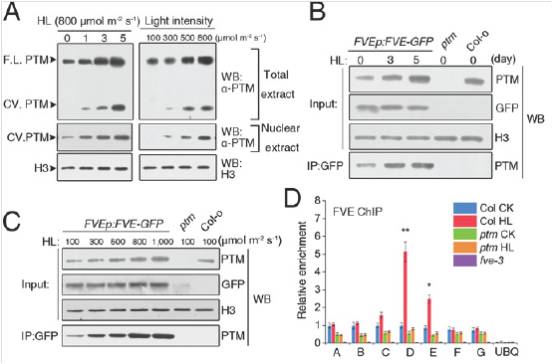Flowering, is a crucial developmental switch in higher plants (the transition from the vegetative phase to the reproductive phase), and is profoundly affected by various environmental and endogenous factors, including light, temperature, hormone status, and age. Proper timing of flowering transition is vital for the reproductive success of plants and orchestrated by endogenous and external factors; light is one of the most prominent environmental factors in the regulation of flowering at multiple levels. In contrast to our detailed understanding of light quality and photoperiod mechanisms involved, the molecular basis underlying high light-promoted flowering remains elusive.
ZHANG Lixin’s group at Institute of Botany, Chinese Academy of Sciences (CAS) have revealed that PTM, a chloroplast envelope-bound plant homeodomain (PHD) transcription factor with transmembrane domains, functions in multiple retrograde signal pathways (Nature Communications, 20112:477). In this study, ZHANG’s Group shows that promotion of flowering by high light involves the coupling of chloroplast retrograde signals and transcriptional silencing of the floral repressor FLOWERING LOCUS C (FLC). In response to high light, a chloroplast envelopelocalized transcription factor, PTM, releases its N-terminal fragment through processing to associate with the chromatin remodeler FVE and suppresses FLC transcription. This report reveals an unexpected role of chloroplasts in high light-mediated flowering, and has established a molecular framework that links the functional state of the endosymbiotic organelles to the nuclear transcriptional regulation of FLC through a retrograde signaling pathway. And also provides a unique perspective on how plastid information is perceived and translated into the histone code through intracellular coordination to control plant developmental reprogramming and growth.
These results were recently online published on the PNAS (www.pnas.org/cgi/doi/10.1073/pnas.1521599113). The PhD student FENG Peiqiang of ZHANG’s group is the first author of the paper. This work was supported by the Major State Basic Research Development Program (Grant 2015CB150100) and the National Natural Science Foundation of China (Grant 31370273).

Figure1: High light regulates the accumulation of N-PTM in the nucleus and its interaction with FVE.
CONTACT INFO:
ZHANG Lixin
Key Laboratory of Plant Photobiology
Institute of Botany,
Chinese Academy of Sciences,
20 Nanxincun, Xiangshan, Beijing 100093, China
E-mail: zhanglixin@ibcas.ac.cn
Flowering, is a crucial developmental switch in higher plants (the transition from the vegetative phase to the reproductive phase), and is profoundly affected by various environmental and endogenous factors, including light, temperature, hormone status, and age. Proper timing of flowering transition is vital for the reproductive success of plants and orchestrated by endogenous and external factors; light is one of the most prominent environmental factors in the regulation of flowering at multiple levels. In contrast to our detailed understanding of light quality and photoperiod mechanisms involved, the molecular basis underlying high light-promoted flowering remains elusive.
ZHANG Lixin’s group at Institute of Botany, Chinese Academy of Sciences (CAS) have revealed that PTM, a chloroplast envelope-bound plant homeodomain (PHD) transcription factor with transmembrane domains, functions in multiple retrograde signal pathways (Nature Communications, 20112:477). In this study, ZHANG’s Group shows that promotion of flowering by high light involves the coupling of chloroplast retrograde signals and transcriptional silencing of the floral repressor FLOWERING LOCUS C (FLC). In response to high light, a chloroplast envelopelocalized transcription factor, PTM, releases its N-terminal fragment through processing to associate with the chromatin remodeler FVE and suppresses FLC transcription. This report reveals an unexpected role of chloroplasts in high light-mediated flowering, and has established a molecular framework that links the functional state of the endosymbiotic organelles to the nuclear transcriptional regulation of FLC through a retrograde signaling pathway. And also provides a unique perspective on how plastid information is perceived and translated into the histone code through intracellular coordination to control plant developmental reprogramming and growth.
These results were recently online published on the PNAS (www.pnas.org/cgi/doi/10.1073/pnas.1521599113). The PhD student FENG Peiqiang of ZHANG’s group is the first author of the paper. This work was supported by the Major State Basic Research Development Program (Grant 2015CB150100) and the National Natural Science Foundation of China (Grant 31370273).

Figure1: High light regulates the accumulation of N-PTM in the nucleus and its interaction with FVE.
CONTACT INFO:
ZHANG Lixin
Key Laboratory of Plant Photobiology
Institute of Botany,
Chinese Academy of Sciences,
20 Nanxincun, Xiangshan, Beijing 100093, China
E-mail: zhanglixin@ibcas.ac.cn